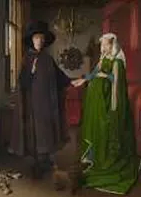BREED HISTORY
The Northern Griffon Bruxellois Club
History of the Griffon Bruxellois


There are two opposing theories that have been put forward by various authorities on the breed over the years. On one hand the breed is thought by some to be some centuries old, this is based mainly on the belief that the dog appearing on the Jan Van Eyck painting `The Wedding of Arnolfini' dated 1434 is a Griffon. Certainly the little dog depicted does bear a slight resemblance to the breed but there are also claims that this dog is the ancestor of other toy breeds, it is possible of course that this dog is just a type from which many small breeds developed.
On the other hand it is said the breed did not exist until 1880in which year a Griffon type dog won a third prize in a variety class at the Great Dog Show in Brussels and was very much admired and Belgian breeders tried to obtain them, so started the popularity and the development of the breed. It should be noted that another painting neuse au`La Baig Griffon' of 1870 depicted a small black and tan dog, but as the term 'Griffon' merely means 'rough-coated' it is no proof that this dog, with its' longish nose is an example of an early Griffon Bruxellois.
There is probably a little truth in both theories, the forerunner of the breed was almost certainly a small rough coated terrier type dog that had been around some time in the streets of Brussels, they were much favoured by the coachmen of the city who kept them in the stables as ratters and were referred to `Stable E'curie' and sometimes `little street urchins'. Often the cabbies would let them ride in the coaches where they became a familiar sight and popular with ladies who loved their pert, cheeky expressions.
Probably a few chance matings produced a slightly different look and they began to be noticed, eventually they became fashionable and breeders started to introduce crosses of various kinds - Pugs which gave the breed the large head and eye and also the black colouration and smooth coats, and the ruby King Charles Spaniel reinforced the flat face and added richness of colour to the red coat but also unfortunately introducing the domed skull, large ears and webbed foot (which is still to be seen today). It is also claimed that Yorkshire Terriers were used and that the often seen silky top-knot is a product of these crossings.
In Belgium during 1880 the `Club du Griffon Bruxellois' was formed and a standard drawn up, LOSH registrations and the first breed classes followed in 1883 and the breed went from strength to strength soon gaining admirers from other European countries and America. In the 1890’s many Griffons were exported which began to alarm Belgian breeders as some of the best dogs were leaving their country of origin. The dog who had won at the Brussels show in 1880 `Tom' (or Vom this is not quite clear) was in fact purchased by an Englishman who brought him to Britain, before his departure he was used at stud on a Barbet bitch producing a dog `Fox' who was a popular stud dog and in fact was the grandfather of the first British Champion. There is no trace of Tom in the Kennel Club stud books but it was not long before more Griffons found their way here and the original imports were entered under `Foreign Dogs', although a few Griffons were traced in 1895 it was not until 1896 that the first four authenticated imports appear in the stud book. In 1898 the breed was recognised by the Kennel Club and given separate register status, there were only three registered in that year, two of these went on to become the first and second British champions, namely Bruno and Mousequetaire Rouge. Around this time quarantine regulations were beginning to take effect and the ruling that dogs born after 1895 with cropped ears could not be shown gave British breeders the incentive to produce their own stock.
The First World War proved a difficult time for Belgian breeders but they recovered enough to continue breeding and exporting Griffons, but between then and the Second World War it was decided that any web-footed stock should not be bred from, and although the fault was eradicated there it caused a decline in the breed and by 1939 it was in a sorry state numerically, during the war years there was no breeding and by 1945 the Griffon had almost disappeared in its native country. The tide had turned and now British breeders were exporting stock to Belgium.
Although registration have never been very high, the Griffon became quite popular here in the early part of the last century, and in the 1920's and 30's were around 150-200, after the war there was a steady rise during the 1950's until it peaked in 1962 with 627. Since then there has been a steady decline and they are now back to around the 150-200 mark.
 THE NORTHERN GRIFFON BRUXELLOIS CLUB
THE NORTHERN GRIFFON BRUXELLOIS CLUB